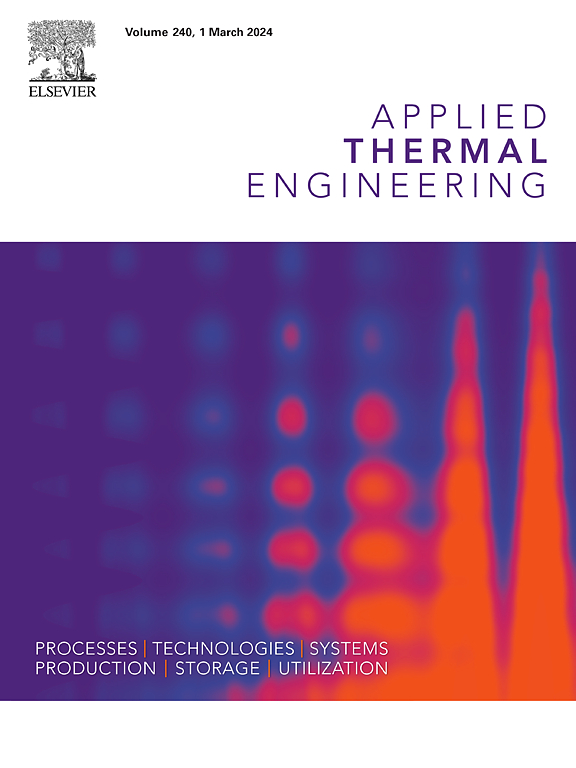Machine learning analysis for heat transfer enhancement in nano-encapsulated phase change materials within L-shaped enclosure with heated blocks
IF 6.1
2区 工程技术
Q2 ENERGY & FUELS
引用次数: 0
Abstract
Phase change materials(PCMs) are crucial to energy storage systems due to their enhanced thermal properties. They significantly boost energy efficiency and promote sustainability. Nevertheless, the low thermal conductivity of PCMs presents a significant challenge, which is addressed by utilizing nano-encapsulation to enhance energy efficiency in energy storage systems. Motivated by this, the current study conducts a theoretical investigation to explore the heat transfer characteristics in a buoyancy-driven Nano-Encapsulated Phase Change Materials(NEPCM) nanofluid within an L-shaped porous enclosure with the impacts of a heated block and magnetic field. Furthermore, the fusion temperature plays a crucial role in initiating phase change in NEPCM, thereby impacting the heat transfer process. Hence, identifying the optimal fusion temperature is essential. To accomplish this, a machine learning approach was employed to identify the ideal fusion temperature. A dataset of 160 data points across four different fusion temperature values was used in this analysis. Additionally, the machine learning model analyzed how variations in fusion temperatures impact physical parameters. An in-house Matlab code is utilized to solve the dimensionless fluid transport equations employing the finite difference method. The results indicate that increasing the nanoparticle volume fraction significantly enhances the heat transfer rate across all physical parameters. Specifically, under higher thermal buoyancy force, increasing the volume fraction from 1% to 5% results in a 90.04% increase in the heat transfer rate. The numerical analysis demonstrates that heat transfer rates improve significantly when the fusion temperature is adjusted to 0.5, a result further validated by machine learning techniques. At this temperature, thermal buoyancy force increases by 0.98% and 2.68% compared to values of 0.1 and 0.9, respectively, while the Stefan number shows increases of 159.42% and 87.48% under these conditions; thereby, the heat transfer rate increases at this value. This computational study provides important insights into the significance of fusion temperature, emphasizing the need to determine its optimal value for improving heat transfer. Identifying this optimal value can enhance the efficiency of thermal energy storage systems and improve cooling performance in electronic devices.
在带加热块的 L 型围墙内增强纳米封装相变材料传热的机器学习分析
相变材料(PCMs)具有增强的热性能,对储能系统至关重要。它们大大提高了能源效率,促进了可持续发展。然而,相变材料的低导热性带来了巨大挑战,而利用纳米封装技术提高储能系统的能效则可以解决这一问题。受此启发,本研究进行了一项理论研究,探讨了在加热块和磁场的影响下,L 型多孔外壳内浮力驱动的纳米封装相变材料(NEPCM)纳米流体的传热特性。此外,熔融温度在引发 NEPCM 相变方面起着关键作用,从而影响传热过程。因此,确定最佳熔融温度至关重要。为此,我们采用了一种机器学习方法来确定理想的熔融温度。该分析使用了一个包含 160 个数据点的数据集,这些数据点跨越四个不同的融合温度值。此外,机器学习模型还分析了融合温度的变化对物理参数的影响。利用内部 Matlab 代码,采用有限差分法求解无量纲流体传输方程。结果表明,在所有物理参数中,提高纳米粒子体积分数可显著提高传热速率。具体而言,在较高的热浮力条件下,将体积分数从 1%提高到 5%可使传热速率提高 90.04%。数值分析表明,当熔融温度调整到 0.5 时,传热率会显著提高,机器学习技术进一步验证了这一结果。在此温度下,热浮力与 0.1 和 0.9 的数值相比,分别增加了 0.98% 和 2.68%,而斯特凡数在这些条件下则分别增加了 159.42% 和 87.48%;因此,热传导率在此数值下也有所提高。这项计算研究提供了关于熔融温度重要性的重要见解,强调了确定其最佳值以改善传热的必要性。确定最佳值可以提高热能存储系统的效率,改善电子设备的冷却性能。
本文章由计算机程序翻译,如有差异,请以英文原文为准。
求助全文
约1分钟内获得全文
求助全文
来源期刊

Applied Thermal Engineering
工程技术-工程:机械
CiteScore
11.30
自引率
15.60%
发文量
1474
审稿时长
57 days
期刊介绍:
Applied Thermal Engineering disseminates novel research related to the design, development and demonstration of components, devices, equipment, technologies and systems involving thermal processes for the production, storage, utilization and conservation of energy, with a focus on engineering application.
The journal publishes high-quality and high-impact Original Research Articles, Review Articles, Short Communications and Letters to the Editor on cutting-edge innovations in research, and recent advances or issues of interest to the thermal engineering community.
 求助内容:
求助内容: 应助结果提醒方式:
应助结果提醒方式:


